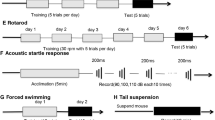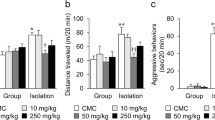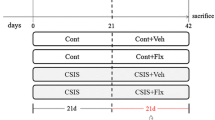Abstract
Rationale
Long-term individual housing increases aggressive behavior in mice, a condition termed isolation-induced aggression; this aggressiveness is reduced by some antidepressants and anxiolytics. NMDA antagonists also inhibit isolation-induced aggression in mice. The enzyme N-acetylated-α-linked acidic dipeptidase (NAALADase) hydrolyzes the neurotransmitter N-acetylaspartylglutamate (NAAG) to form glutamate and N-acetylaspartate; NAAG acts as a partial NMDA agonist as well as a full agonist at the presynaptic metabotropic glutamate receptor 3 (mGluR3), where it acts to reduce glutamate release.
Objective
We postulated that NAALADase inhibition would reduce isolation-induced aggression in mice.
Methods
We tested whether acute exposure to the NAALADase inhibitor 2-[[hydroxy[2,3,4,5,6-pentafluorophenyl)methyl]phosphinyl]methyl] pentanedioic acid (GPI-5232), administered 30 min prior to a social interaction test, would inhibit aggressive behavior in SJL mice that had been individually housed long term.
Results
Administration of GPI-5232 (30 mg/kg, IP) inhibited initiation of aggressive behavior, indicated by greater latencies to display tail-rattling, attack and biting, and by fewer mice initiating aggressive behavior, compared to mice that received vehicle. In addition, GPI-5232 treated mice had fewer tail-rattling responses to a non-aggressive conspecific.
Conclusions
The effectiveness of GPI-5232 in this animal model suggests that NAALADase inhibition may be a novel therapeutic approach to reduce or inhibit heightened aggressiveness, and possibly to treat aggressive behavior associated with psychiatric disorders.




Similar content being viewed by others
References
Anton AH, Schwartz RP, Kramer S (1968) Catecholamines and behavior in isolated and grouped mice. J Psychiatr Res 6:211–220
Belozertseva IV, Bespalov AY (1999) Effects of NMDA receptor channel blockade on aggression in isolated male mice. Aggress Behav 25:381–396
Belzung C, Berton F (1997) Further pharmacological validation of the balb/c neophobia in the free exploratory paradigm as an animal model of trait anxiety. Behav Pharmacol 8:541–548
Berman RM, Cappiello A, Anand A, Oren DA, Heninger, GR, Charney, DS Krystal JH (2000) Antidepressant effects of ketamine in depressed patients. Biol Psychiatry 47:351–354
Blanchard D, Blanchard R, De Padua Carobrez A, Veniegas R, Rodgers R, Shepherd JK (1992) MK-801 produces a reduction in anxiety-related antipredator defensiveness in male and female rats and a gender-dependent increase in locomotor behavior. Psychopharmacology 108:352–362
Blindermann JM, DeFeudis FV, Maitre M, Misslin R, Wolff P, Mandel P (1979) A difference in glutamate-decarboxylase activity between isolated and grouped mice. J Neurochem 32:1357–1359
Blindermann JM, DeFeudis FV, Maitre M, Misslin R, Mandel P (1980) Glutamate decarboxylase activity in brain regions of differentially-housed mice; a difference in the olfactory bulb. Experientia 36:853–854
Brain PF, Nowell N (1971) Isolation versus grouping effects on adrenal and gonadal function in albino mice. 1. The male. Gen Comp Endocrinol 16:149–154
Chojnacka-Wolcik E, Tatarczynska E, Pilc A (1996) Anxiolytic-like effects of metabotropic glutamate antagonists (RS)-alpha-methylserine-o-phosphate in rats. Pol J Pharmacol 48:507–509
Chojnacka-Wojcik E, Tatarczynska E, Pilc A (1997) The anxiolytic-like effect of metabotropic glutamate receptor antagonists after intrahippocampal injection in rats. Eur J Pharmacol 319:153–156
Coyle J (1997) Minireview: the nagging question of the function of N-acetylaspartylglutamate. Neurobiol Dis 4:231–238
Coyle JT, Puttfarcken P (1993) Oxidative stress, glutamate, and neurodegenerative disorders. Science 262:689–695
Coyle JT, Stauch-Slusher B, Tsai G, Rothstein J, Meyerhoff JL, Simmons M, Blakely RD (1991) N-Acetyl-aspartyl glutamate: recent developments. In: Meldrum RS, Moroni F, Simon RP, Woods JH (eds) Excitatory amino acids. Raven Press, New York, pp 69–77
Crawley J (2000) What’s wrong with my mouse? Behavioral phenotyping of transgenic and knockout mice. Wiley, New York
DeFeudis FV, Madtes P, Camacho G (1976) Binding of glycine and gamma-aminobutyric acid to synaptosomal fractions of the brains of differentially-housed mice. Exp Neurol 50:207–213
Denenberg VH, Gaulin-Kremer E, Gandelman R, Zarrow MX (1973) The development of standard stimulus animals for mouse (Mus musculus) aggression testing by means of olfactory bulbectomy. Anim Behav 21:590–598
Earley CJ, Leonard BE (1977) The effect of testosterone and cyproterone acetate on the concentration of gamma-aminobutyric acid in brain areas of aggressive and non-aggressive mice. Pharmacol Biochem Behav 6:409–413
Eichelman BS (1990) Neurochemical and psychopharmacologic aspects of aggressive behavior. Annu Rev Med 41:149–158
Fava M (1997) Anger, aggression, and violence. Psychopharmacologic treatment of pathologic aggression. Psychiatr Clin N Am 20:427–447
File S, Tucker J (1986) Behavioral consequences of antidepressant treatment in rodents. Neurosci Biobehav Rev 10:123–134
Forloni G, Grzanna R, Blakely R, Coyle JT (1987) Co-localization of N-acetyl-aspartyl-glutamate in central cholinergic, noradrenergic, and serotonergic neurons. Synapse 1:455–460
Ghose S, Wroblewska B, Corsi L, Grayson DR, De Blas AL, Vicini S, Neale JH (1997) N-Acetylaspartylglutamate stimulates metabotropic glutamate receptor 3 to regulate expression of the GABA(A) alpha6 subunit in cerebellar granule cells. J Neurochem 69:2326–2335
Grant EC, Mackintosh JH (1963) A comparison of the social postures of some common laboratory rodents. Behaviour 21:246–257
Helton D, Tizzano J, Monn J, Schoepp D, Kallman J (1998). Anxiolytic and side-effect profile of LY354740: a potent, highly selective, orally active agonist for group II metabotrophic glutamate receptors. J Pharmacol Exp Ther 284:651–660
Kehne JH, McCloskey TC, Baron BM, Chi EM, Harrison BL, Whitten JP, Palfreyman MG (1991) NMDA receptor complex antagonists have potential anxiolytic effects as measured with separation-induced ultrasonic vocalizations. Eur J Pharmacol 193:283–292
Krystal JH, D’Souza DC, Petrakis IL, Belger A, Berman RM, Charney DS, Abi-Saab W, Madonick S (1999) NMDA agonists and antagonists as probes of glutamatergic dysfunction and pharmacotherapies in neuropsychiatric disorders. Harv Rev Psychiatry 7:125–143
Lu XM, Tang Z, Liu W, Lin Q, Slusher BS (2000) N-Acetylaspartylglutamate protects against transient focal cerebral ischemia in rats. Eur J Pharmacol 408:233–239
Lumley LA, Slusher BS, Morton DM, Charles RC, Charles RF, Saviolakis GA, Meyerhoff JL (1999) Behavioral effects of NAALADase inhibition in socially defeated male mice. Neurosci Absr 29:30.6
Lumley LA, Charles RF, Charles RC, Hebert MA, Morton DM, Meyerhoff JL (2000) Effects of social defeat and diazepam on behavior in a resident-intruder test in male DBA/2 mice. Pharmacol Biochem Behav 67:433–447
McAllister K (1990) Ethiological analysis of the effects of MK-801 upon aggressive male mice: similarity to chlordiazepoxide. Pharmacol Biochem Behav 37:101–106
Marcucci F, Giacalone E (1969) N-Acetyl aspartic, aspartic and glutamic acid brain levels in aggressive mice. Biochem Pharmacol 18:691–692
Meyerhoff JM, Robinson MB, Bixler MA, Richards SS, Coyle JT (1989) Seizures decrease regional enzymatic hydrolysis of N-acetyl-aspartylglutamate in rat brain. Brain Res 505:130–134
Miczek K, O’Donnell J (1978) Intruder-evoked aggression in isolated and nonisolated mice: effects of psychomotor stimulants and l-dopa. Psychopharmacology 57:47–55
Miczek KA, Maxson SC, Fish EW, Faccidomo S (2001) Aggressive behavioral phenotypes in mice. Behav Brain Res 125:167–181
Monn J, Valli M, Massey SM et al. (1997) Design, synthesis, and pharmacological characterization of (+)-2-aminobicyclo[3.1.0]hexane-2,6-dicarboxylic acid (LY354740): a potent, selective, and orally active group 2 metabotropic glutamate receptor agonist possessing anticonvulsant and anxiolytic properties. J Med Chem 40:528–537
Neale JH, Bzdega T Wroblewska B (2000) N-Acetylaspartylglutamate: the most abundant peptide neurotransmitter in the mammalian central nervous system. J Neurochem 75:443–452
Nowak GB, Legutko B, Skolnick P, Popik P (1998) Adaptation of cortical NMDA receptors by chronic treatment with specific serotonin reuptake inhibitors. Eur J Pharmacol 342:367–370
Ossowska G, Klenek-Majewska B, Szymczyk G (1997) The effect of NMDA antagonists on footshock-inuced fighting behavior in chronically stressed rats. J Physiol Pharmacol 48:127–135
Petrie RI, Reid IC, Stewart CA (2000) The N-methyl-d-aspartate receptor, synaptic plasticity, and depressive disorder. A critical review. Pharmacol Ther 87:11–25
Przegalinski E, Tatarczynska E, Deren-Wesolek A, Chojnacka-Wojcik E (1996) Anticonflict effects of a competitive NMDA receptor antagonist and a partial agonist at strychnine-insensitive glycine receptors. Pharmacol Biochem Behav 54:73–77
Skolnick P (1999) Antidepressants for the new millennium. Eur J Pharmacol 375:31–40
Skolnick P Reed GF, Paul SM (1985) Benzodiazepine-receptor mediated inhibition of isolation-induced aggression in mice. Pharmacol Biochem Behav 23:17–20
Skolnick P, Layer RT, Popik P, Nowak G, Paul IA, Trullas R (1996) Adaptation of N-methyl-d-aspartate (NMDA) receptors following antidepressant treatment: implications for the pharmacotherapy of depression. Pharmacopsychiatry 29:23–26
Slusher BS, Vornov JJ, Thomas AG, Hurn PD, Harukuni I, Bhardwaj A, Traystman RJ, Robinson MB, Britton P, Lu XC, Tortella FC, Wozniak KM, Yudkoff M, Potter BM, Jackson PF (1999) Selective inhibition of NAALADase, which converts NAAG to glutamate, reduces ischemic brain injury. Nat Med 5:1396–402
Spooren WJPM, Vassout A, Neijt HC, Kuhn R, Gasparini F, Foux S, Porsolt RD, Gentsch C (2000) Anxiolytic-like effects of the prototypical metabotropic glutamate receptor 5 antagonist 2-methyl-6-(phenylethynyl)pyridine in rodents. J Pharmacol Exp Ther 295:1267–1275
Sukhotina IA, Bespalov AY (2000) Effects of the NMDA receptor channel blockers memantine and MRZ 2/579 on morphine withdrawal-facilitated aggression in mice. Psychopharmacology 149:345–350
Tricklebank ML, Singh L, Oles RJ, Preston C, Iversen SD (1989) The behavioural effects of MK-801: a comparison with antagonists acting non-competitively and competitively at the NMDA receptor. Eur J Pharmacol 167:127–135
Trullas R, Skolnick P (1990) Functional antagonists at the NMDA receptor complex exhibit antidepressant actions. Eur J Pharmacol 185:1–10
Valzelli L (1969) Aggressive behavior induced by isolation. In: Garattini S, Sigg EB (eds) Aggressive behaviour. Excerpta Medica Foundation, Amsterdam, pp 70–76
Valzelli L (1973) The “isolation syndrome” in mice. Psychopharmacologia 31:305–320
Valzelli L (1974) 5-Hydroxytryptamine in aggressiveness. Adv Biochem Psychopharmacol 11:255–263
Vornov JJ, Wozniak K, Lu M, Jackson P, Tsukamoto T, Wang E, Slusher B (1999) Blockade of NAALADase: a novel neuroprotective strategy based on limiting glutamate and elevating NAAG. Ann N Y Acad Sci 890:400–405
Wedzony K, Mackowiak M, Zajaczkowski W, Fijat K, Chocyk A, Czyrak A (2000) WAY 100135, an antagonist of 5-HT1A serotonin receptors, attenuates psychotomimetic effects of MK-801. Neuropsychopharmacology 23:547–559
White SM, Kucharik RF, Moyer JA (1991) Effects of serotonergic agents on isolation-induced aggression. Pharmacol Biochem Behav 39:729–736
Wiley J (1997) Behavioral pharmacology of N-methyl-d-aspartate antagonists: implications for the study and pharmacotherapy of anxiety and schizophrenia. Exp Clin Psychopharmacol 5:365–374
Wiley JL, Cristello AF, Balster RL (1995) Effects of site-selective NMDA receptor antagonists in an elevated plus-maze model of anxiety in mice. Eur J Pharmacol 294:101–107
Williams AJ, Lu XM, Slusher BS, Tortella FC (2001) Electroencephalogram analysis and neuroprotective profile of the N-acetylated-alpha-linked acidic dipeptidase inhibitor, GPI5232, in normal and brain-injured rats. J Pharmacol Exp Ther 299:48–57
Wilmot C, Venderwende C, Spoerlein MT (1987) The effects of phencyclidine on fighting in differentially housed mice. Pharmacol Biochem Behav 28:341–346
Winslow JT, Insel TR, Trullas R, Skolnick P (1990) Rat pup isolation calls are reduced by functional antagonists of the NMDA receptor complex. Eur J Pharmacol 190:11–21
Xie Z, Commissaris L (1992) Anxiolytic-like effects of the noncompetitive NMDA antagonist MK801. Pharmacol Biochem Behav 43:471–477
Yen CY, Stanger RL, Millman N (1959) Ataractic suppression of isolation-induced aggressive behavior. Arch Int Pharmacodyn Ther 123:179–185
Zhao J, Ramadan E, Cappiello M, Wroblewska B, Bzdega T, Neale JH (2001) NAAG inhibits KCl-induced [(3)H]-GABA release via mGluR3, cAMP, PKA and L-type calcium conductance. Eur J Neurosci 13:340–346
Acknowledgements
Research was supported by DAMD-17-98-1-8634 to J.L. Meyerhoff, and DAMD-17-0041 between Guilford Pharmaceuticals Inc. and WRAIR. The views of the authors do not purport to reflect the position of the Department of the Army or the Department of Defense (paragraph 4-3), AR 360-5.
Author information
Authors and Affiliations
Corresponding author
Rights and permissions
About this article
Cite this article
Lumley, L.A., Robison, C.L., Slusher, B.S. et al. Reduced isolation-induced aggressiveness in mice following NAALADase inhibition. Psychopharmacology 171, 375–381 (2004). https://doi.org/10.1007/s00213-003-1610-z
Received:
Accepted:
Published:
Issue Date:
DOI: https://doi.org/10.1007/s00213-003-1610-z




